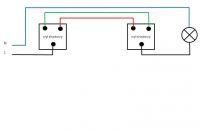Hello. Some time ago, the electrician made the installation, it was time for equipment, but unfortunately he went away for a few months and I do not have access to it now so I mount the sockets and I stopped on the stair connectors and it looks like this:
There are cables in the box at the top: brown, blue, yellow-green - there is no electricity in any of them.
In the primeval bottom: -brown (there is electricity in it, I checked with a test tube), -blue (there is electricity but the bulb in the tube shines less than always, it glows slightly), -yellow-green no electricity.
And now the question. How to connect it to ospel as connectors? I found several schemes of this type:
and according to them it looks like that before connecting only in one box there should be one live wire, not two. Is this done according to some other pattern?
There are cables in the box at the top: brown, blue, yellow-green - there is no electricity in any of them.
In the primeval bottom: -brown (there is electricity in it, I checked with a test tube), -blue (there is electricity but the bulb in the tube shines less than always, it glows slightly), -yellow-green no electricity.
And now the question. How to connect it to ospel as connectors? I found several schemes of this type:

and according to them it looks like that before connecting only in one box there should be one live wire, not two. Is this done according to some other pattern?



